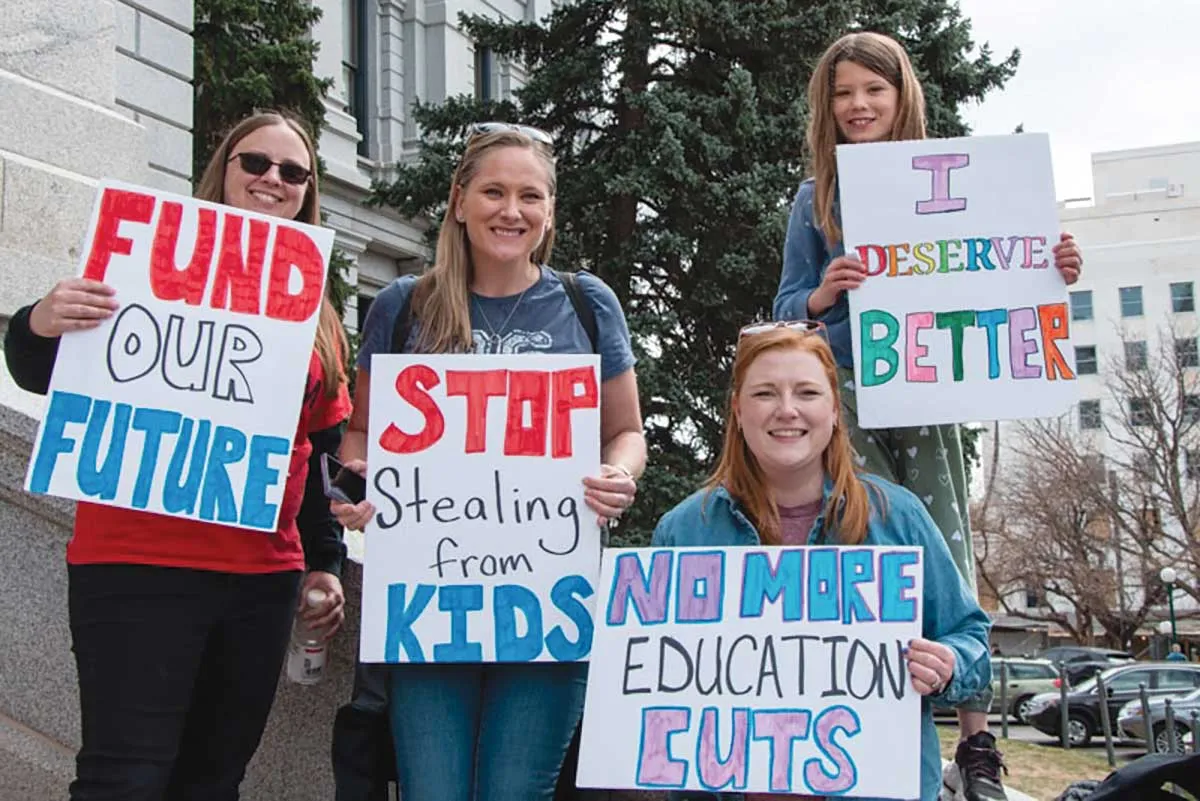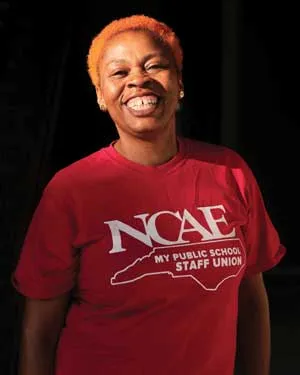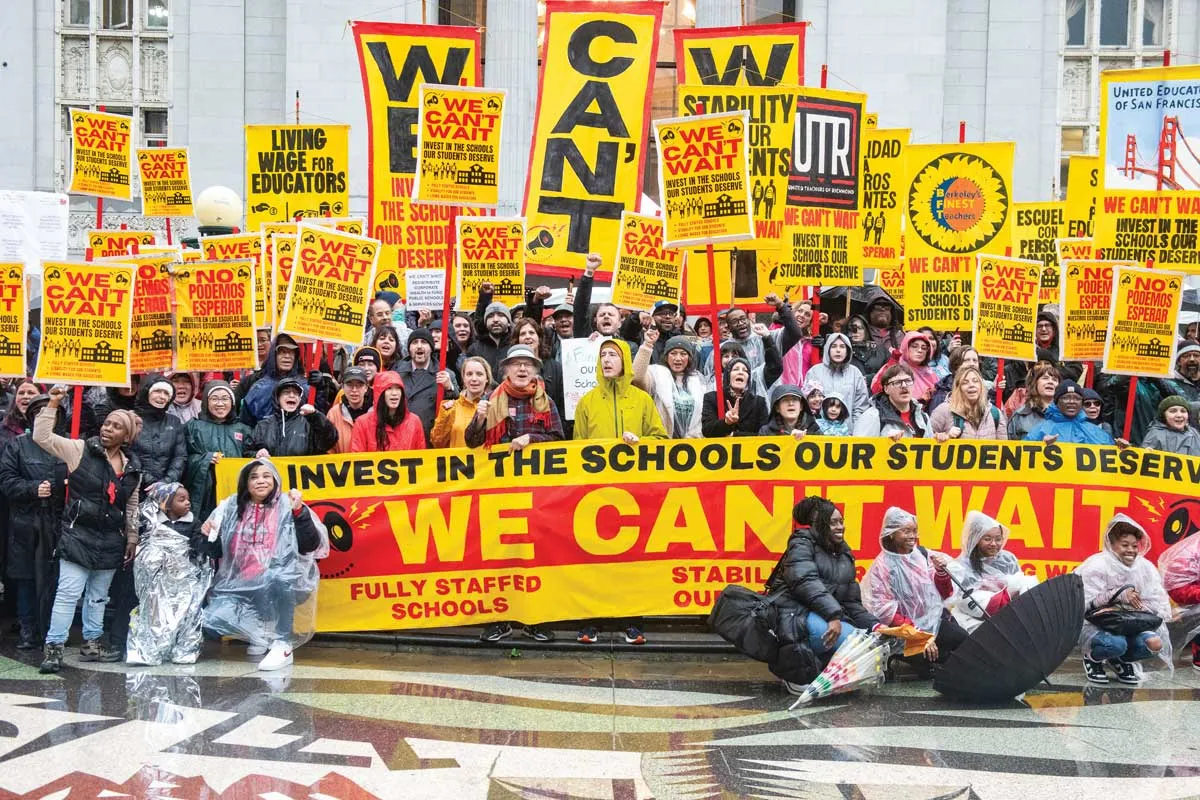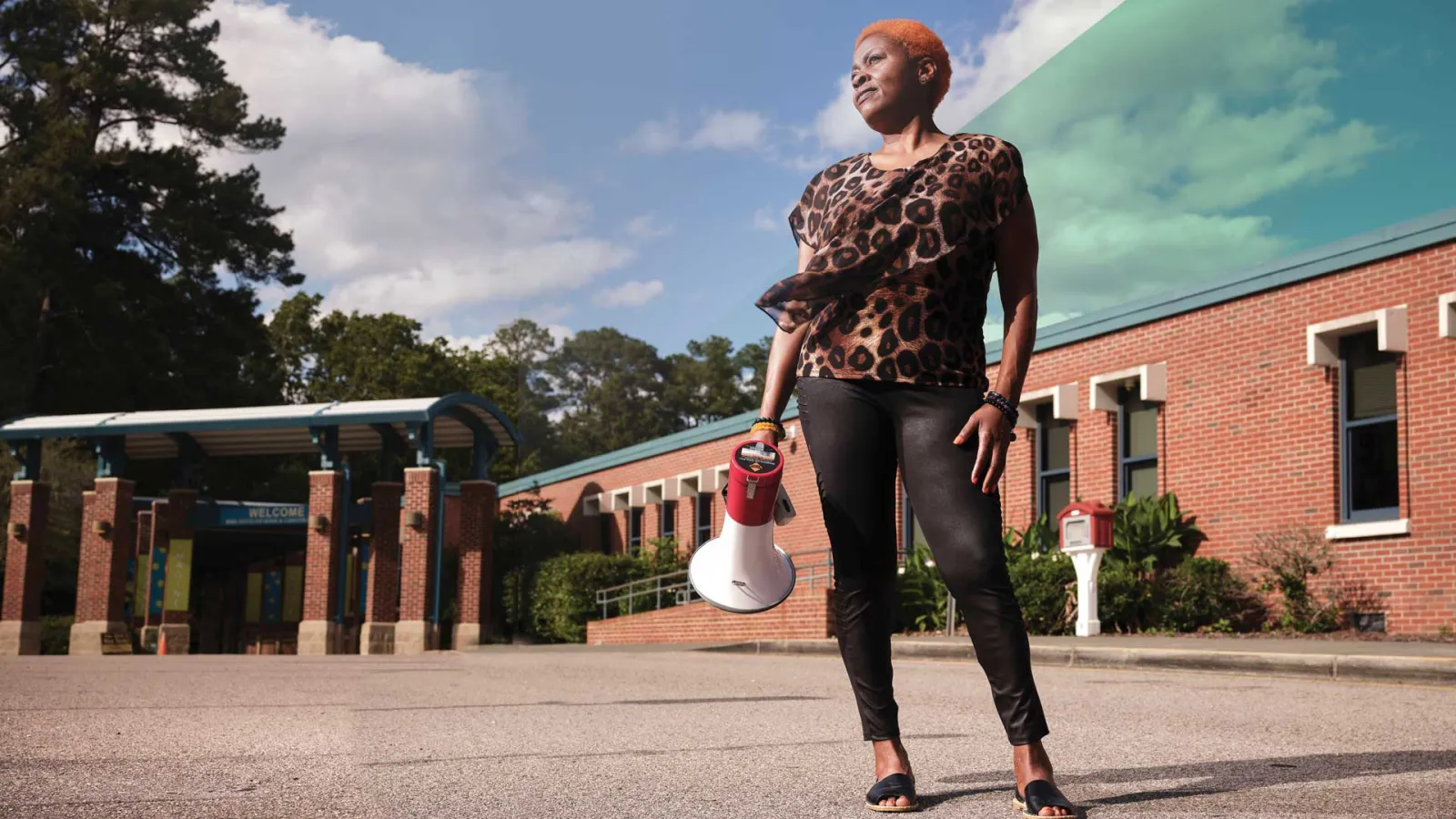Speak Out for Your Students and Your Profession

“I know this sounds alarmist, but I’m literally teaching World War II today and what happens when people don’t stand up,” says Colorado high school teacher Wendy Bergman. “If we aren’t the ones fighting for our kids and communities, then no one is.”
In spring, Bergman and other Colorado Education Association (CEA) members organized a “No More Education Cuts” rally that drew more than 8,000 supporters to Denver.
It was so big that districts closed schools for the day. It was so powerful that not only did lawmakers cancel the cuts, they increased funding to schools.
“We have the power!” says Bergman, a high school teacher in the Poudre School District.
They also have the ability and motivation, says Bethany Fritz, an occupational therapist in Westminster, Colo. “I’m sure people are already going to their principals to ask for resources for students. That’s advocacy. It’s all about getting what your students need,” she says.

Know your rights
While advocating for yourself and your students, keep a few things in mind.
- When you are off duty, you generally have the same rights as other citizens to attend protests, sign petitions, etc. But be clear you are speaking for yourself or your union, not on behalf of your employer.
- Your speech rights are more limited at work. Public employers generally have the right to control what employees say on the job.
- Have a question? Consult your union!

Together, NEA members have used their collective power to successfully raise educator wages, improve working conditions, support student loan forgiveness, and make sure the voices of educators are heard.
A Case Study: The Power of Telling Your Story

“If we can’t afford to live, how can we afford to teach?” University of Minnesota-Duluth graduate Caitlin Efta asked state lawmakers at a committee hearing last year.
She and her classmates spent their few dollars on cheap food and gas to get to their student teaching assignments. Efta, a special education major, also worked nights and weekends. After hearing from her and other Aspiring Educators, Minnesota’s legislature approved a $7,500 stipend for student teachers.
Efta’s advice? “Tell your story from the heart. … Legislators aren’t going to understand our side of the story unless they can see it through our eyes.”
Feel Safe at School
Warner—whose student-related injuries have included concussions and a fractured nose—joined other NYSUT (New York State United Teachers) members in advocating relentlessly for school employees to be protected by law. Now, NYSUT staff is training hundreds of members statewide on how to implement the new rules.
Federal law entitles all workers to have safe and healthy workplaces. If this isn’t happening for you, your union can help.

Thanks to the expanded New York law, Saratoga Springs union leaders are ensuring that members report behavioral incidents and are using that data in conversations with administrators, says Rana Hughes, a third-grade teacher and local union co-president.
When educators are reluctant to report, she tells them: “It’s not just for you. It’s for your students. … This data collection is about getting your students what they need.”

They are still kids, says Mike Modleski, a high school teacher and union president in Victor, N.Y. “The more heightened the behavior, the more help that kid needs,” he says. “The best solutions obviously come when all the stakeholders come together and move in the same direction.
That’s what union leaders do. We force conversations to happen.”

3 Solutions to Student Violence
- Collect and report data.
Accurate data is necessary to secure additional safety and support measures. It’s also essential for obtaining employee benefits for long-term care, such as workers’ compensation as well as toxic stress and wellness supports. Access to these resources often requires documentation of the incident and injuries.
- Bargain for safety provisions.
In Washington, the contract for the Kent Education Association (KEA) says, “Any student found to have assaulted, made a threat against, or harassed an employee will not be returned to the employee’s classroom or instructional area without mutual approval of the employee and building administrator.” Additional language enables a KEA representative to leave their classroom to assess and support the staff member’s emotional well-being.
- Take it to the board!
Use NEA’s sample resolution language to ask your school board to create a labor-management health and safety committee, which can tackle issues like workplace violence, extreme temperatures, poor indoor air quality, and more. Visit nea.org/HealthySchools.
Act Like a Union Member

The North Carolina Association of Educators (NCAE) is one of the fastest growing unions in the nation. Crews is a member through her local union, Wake NCAE, representing educators in the state’s largest school district.
A few months ago, Crews was fed up. She could no longer sit back and watch her students suffer from a lack of air-conditioning and heat in school. So she agreed to speak at her local union’s health and safety town hall meeting.
“There have been times when I’ve gone out and purchased fans out of pocket,” she told the crowd. “Kids ask me, ‘Ms. Crews, when are we going to get heat or air-conditioning?’ A lot of times, I don’t have an answer—and that’s why I’m here tonight.”
Unions have power, no matter where you live
The South has got some?thing to say, and it’s that unions are here. They’re here in Wake County and across North Carolina, and also in every Midwest or Mountain state that might be called “right-to-work.” (A more accurate label? “Anti-worker.”)
What does the law say?
There is no state in this nation where unions are illegal. No matter where you live, every educator has the right to join a union—and act like a union member.
States differ in how educators can advocate for pay, benefits, and student learning conditions. In most states, collective bargaining is legal. In others, educators can still leverage political and community power by speaking up and working with parents and allies.
Last year in Wake County, more than two dozen public schools closed for at least a day because of unsafe indoor temperatures, impacting 20,000 students and staff.
The problem: Students can’t learn when they’re wrapped in blankets or begging to lie down on the cool tile floor. The solution? Union members want county commissioners to put a multimillion-dollar school maintenance bond on the ballot in fall 2026—and they’re using their collective voice to make it happen.
“We are building our power as a union,” says Wake NCAE President Christina Cole, “and we will do all the things it takes to win.”
Head custodian Patricia Crews is a proud member of Wake NCAE, the union representing educators in North Carolina’s largest school district.
You Are the Union
- Connect with your local.
Make sure you know who your building or worksite rep is. Put your building and local meetings on your calendar and bring a friend!
- Show your union pride!
Wear your union T-shirt. Hang a new NEA poster. (They are beautiful!)
- Talk about the union with your colleagues.
When you talk about the difference the union is making in your life, you are helping to grow your union—and our power.
Get everything you need to act like a union member—including posters, conversation guides, and more—at nea.org/UnionBulletin.
Keep Immigrant Students Safe

The reason for the sudden rush? To avoid getting caught in a raid by U.S. Immigration and Customs Enforcement (ICE), says Virginia school bus driver Ivis Castillo. It’s a fear immigrant families live with every day.
To protect her students, Castillo created her own bus protocol, aligned with district policy: “No one is going to enter. If they want to talk, … [they’ll] have to talk to me by my … driver’s window,” she says, adding that she’ll only release students to parents at school.
In Federal Way Public Schools, in Washington, a high school teacher—who asked to remain anonymous—sees how fear disrupts learning.
“Undocumented students and students with undocumented family members are staying in my classroom after school, watching ICE agents on their doorbell cameras, afraid to go home. Many of them are falling asleep in my class,” she says. “They can’t sleep at night because of their worries. [The stress is] creating a tidal wave of dread, hopelessness, and exhaustion amongst all of the students and staff.”
Around the country, educators and support staff are stepping up in quiet yet profound ways to protect undocumented students.
What does the law say?
Educators who protect students are backed by legal protections.
In 1982, the U.S. Supreme Court ruled in Plyler v. Doe that schools cannot deny a free, public K–12 education based on immigration status.
The Family Educational Rights and Privacy Act bars schools from releasing student records?—immigration status included—without parental consent, except in limited circumstances.
The First Amendment and civil rights laws strongly protect educators right to speak out for their students’ liberties outside of working hours. In class, those protections are more limited.
Earn families’ trust

Erika Ryan, a bilingual family specialist in Arlington, Va., has found ways to support families under pressure. “The goal is to keep kids safe at school and [share] … what actions the school system is taking to [help] all the immigrant families,” Ryan says.
But she’s had to adapt, explaining that families are hesitant to attend public events held at school about immigration. “They are afraid that ICE will show up,” she says.
So she shares information privately—helping them access food pantries, legal resources, and trauma support.
Make schools safe zones
Local unions have turned advocacy into policy.
Arlington Education Association President June Prakash helped the school district adopt NEA’s Safe Zone resolution, which outlines how to respond if ICE shows up.
“The responsibility isn’t on a principal or an educator,” she says. “If somebody identifies themselves as an ICE agent and says they have a warrant, then the administrator at that school is supposed to call the legal counsel of our school system.”

Safe Zone Protections
NEA has created school board policies and resolutions to help districts adopt inclusive protections for marginalized communities—reinforcing the role of collective bargaining at the local level.
Learn more at nea.org/Sample-Resolutions.
To keep students safe from unlawful or harsh immigration enforcement, use NEA’s Safe Zone resolution and model policy as a template for your school district. The language is closely tied to the U.S. Supreme Court case Plyler v. Doe, which is the foundational precedent establishing that access to K–12 education is a civil right.
Go to nea.org/SafeZones to learn more.
Make Space for Every Voice

As a special education teacher and LGBTQ+ advocate, in Louisville, Ky., Fisher sees inclusive education as a cornerstone of safe and effective learning. That sense of belonging, he believes, should be the standard in every school.
“The educator code of ethics in Kentucky states that we must protect the health, safety, and emotional well-being of students,” Fisher says. “That gives me both the responsibility and the right to make sure every kid in my room is seen, valued, and respected.”
Educators across the country share that goal. They want to create classrooms where all students—regardless of race, gender, identity, or ability—can see themselves in the curriculum and feel safe to learn.
What does the law say?
According to a joint report from NEA and the Law Firm Antiracism Alliance, culturally responsive and racially inclusive education not only improves academic outcomes, it also aligns with federal and state laws protecting free speech and equal protection.
Inclusive education also boosts critical thinking, engagement, and graduation rates across all student groups, the report says.
For Fisher, it’s not only policy—it’s a matter of principle. “If I’m willing to take a bullet to protect my students, I’m also going to stand up for these policies,” he says. “These kids are our future. Whether we agree with who they are or not, we owe them dignity, respect, and a chance to learn in peace.”
That, he insists, is the assignment. “And we can’t get distracted. We have to stay with the assignment.”
Yes, you can teach that
But that aspiration is under attack. Since 2021, anti-public education lawmakers in more than 20 states have passed or proposed laws to censor discussions of race, gender identity, and U.S. history in public schools. Many of these efforts are tied to a broader movement to roll back diversity, equity, and inclusion (DEI) practices at the K–12 and higher education levels.
In January 2025, President Donald Trump issued an executive order that leaves educators to wonder whether teaching about slavery, civil rights, or LGBTQ+ figures could be illegal.
NEA, the American Civil Liberties Union and their New Hampshire affiliates sued the U.S. Department of Education over its anti-DEI policy. In April, a federal court blocked the executive order from taking effect while the case moves forward.
Yet, the chilling effect remains. During a February hearing in the U.S. Senate, Secretary of Education Linda McMahon refused to clarify whether schools that teach African American history could lose federal funding.
“I would like to look at these programs to fully understand the breadth of the executive order and get back to you on that,” she said.

America Sotelo, a bilingual teacher in Passaic, N.J., says this kind of evasion illustrates the problem.
“When leaders refuse to give clear answers about what we’re allowed to teach, it creates fear and confusion. … Teachers start second-guessing whether telling the full truth is safe—and that’s where the harm begins,” she says. “Our students … know when something is being left out. And our students, especially those from marginalized communities, feel that erasure deeply.”
The stakes are high
“Inclusive history doesn’t just teach facts. It affirms identity, builds confidence, and invites students to think critically about the world and their place in it,” Sotelo adds.
“I’ve watched bilingual students light up when they recognize their own heritage, struggles, and resilience in the stories we teach. They see themselves as part of the American story, not outside of it.”
Despite mounting pressure, educators are refusing to back down. Many are leaning into their professional training, union support, and personal conviction to keep inclusive education alive.
Fisher, who offers professional development sessions, including “Best Practices for Serving LGBTQ Students,” teaches fellow educators how to navigate today’s charged environment.
“You don’t have to be LGBTQ to be an ally,” he says. “It’s about using your privilege to speak up at tables where others are not represented.”
He walks educators through understanding identity, gender versus sexuality, and how a small act—like a rainbow sticker on a laptop—can serve as a lifeline. “That can be their little glimmer of hope,” he says. “Those little things can snowball into something powerful.”

Tamar LaSure-Owens is working with her union, the New Jersey Education Association, to teach the hidden history of the Underground Railroad in the state.
“Black history is American history,” says LaSure-Owens, a third-grade teacher in the town of Pleasantville.
“To understand history truthfully and accurately, it must include the perspectives, struggles, and achievements of Black people.”

Defending Honest Teaching
NEA encourages local unions to negotiate protections that affirm an educator’s right to teach honestly and to use inclusive material in the classroom. Consider the following and ask your union these questions:
- Can our union work with the district to create a memorandum of understanding (MOU) that protects our ability to teach inclusive, standards-based content without fear of discipline?
Why this matters: Even in states without collective bargaining rights, local unions can sometimes negotiate informal agreements or MOUs with school districts to establish expectations and protections—especially around curriculum and academic freedom.
- Do the agreements provide educators with safe harbor (clauses that protect educators from punishment) if their instruction is in line with state standards or prior practice?
Why this matters: Collective bargaining agreements can ensure that instruction that follows state or national standards—and the educators who teach them—are protected. Even without a union contract, educators can document that their instruction is aligned with state-approved standards. This provides a defensible position if they’re challenged.
- Do the agreements require notice before discipline? Do they provide independent review of terminations?
Why this matters: Strong collective bargaining agreements ensure due process and impartial hearings before discipline—which is especially important in politically charged cases. In Kentucky, for example, an independent tribunal is comprised of an attorney from outside the district, as well as a district teacher and administrator.
Earn a Fair Wage

On top of that, Kelly Liebenthal, a transitional kindergarten teacher, pays $1,300 a month for health care for her family. “It’s just really, really unaffordable to live and work as a teacher in Santa Cruz County,” she says.
And it’s not only there. At the southern end of the state, San Diego high school teacher Eduardo “Kiki” Ochoa says his newer colleagues may never know the satisfaction of home ownership. “Our wage isn’t a livable one.”
All educators should be able to live and work in their communities. Yes, it’s a job “of the heart,” notes Colorado teacher Isabel Rodriguez, but shouldn’t it cover basic bills, too?
One in four teachers across the country struggle to buy food, NEA research has found. Often, the only option for survival is to walk away from the profession, leaving students with a revolving door of inexperienced educators.
The time is now
Through the “We Can’t Wait” campaign, spearheaded by the California Teachers Association (CTA), members in 32 CTA locals—who serve more than 1 million students—are demanding pay that matches their value to society.
It’s time for “wages that will truly humanize the teaching experience,” Ochoa says.
In addition to better pay, the campaign also calls for safe and stable schools— or an end to layoffs and frequent funding cuts—and fully staffed schools with counselors, librarians, social workers, nurses, school psychologists, and all the instructional specialists that students need.
“We’re a small union and we love that there is this big energy and big effort that we can be part of,” Liebenthal says. “I am feeling hopeful!”
A Case Study: 40% Raises!
What would a 40 percent raise mean? For the secretaries, library assistants, school nurses, and other members of the Classified Administrative Professionals Association (CAPA) of Sumner-Bonney Lake, in Washington, it means one job is enough, says administrative secretary and union leader Dawn Palumbo.
About five years ago, CAPA members were driven to unionize by their lower-than-McDonald’s pay. In their first contract, in 2021, they won 25 percent raises, on average, with some getting as much as 36 percent. In 2024, they tacked on another 15 percent, or more if inflation rises. “It’s unfortunate we’ve had to fight so hard, but we were like, ‘Nope, we’re not taking this anymore,’” Palumbo says. With help from the Washington Education Association, union members persevered. “Our bargaining team knew what our members needed—and it has been amazing!”
Find out more about fair pay in your state and gain access to NEA's educator salary report.

We Want to Hear from You
Get more from



